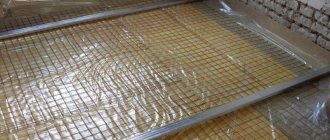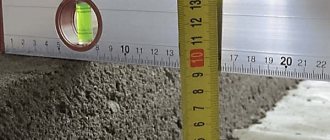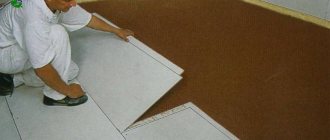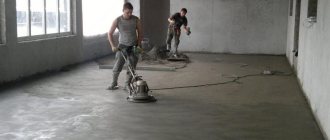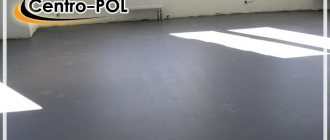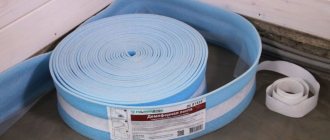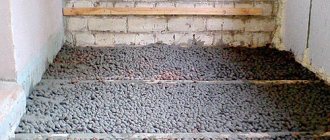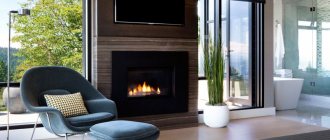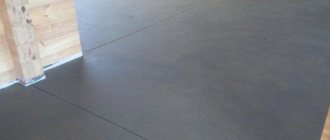Leveling the floors is a mandatory procedure that is performed during any renovation. The best way to get a perfectly level rough foundation is to arrange a screed. However, despite a lot of conversations and articles, few people know what a floor screed is and why it is needed. What types of screeds are there? Which type is better? It's time to take a closer look at this.
What is a floor screed and why is it needed?
Scheme of a two-layer screed for beacons
What is a floor screed?
A screed is a fairly thick layer of sand-cement mixture laid on top of the ceiling, insulating layer or rough base. It is this layer that will serve as the surface on which tiles, laminate, linoleum or any other coating will be mounted.
Installation of semi-dry floor screed
On a note! In utility rooms, basements, and garages, the screed itself can also serve as a finishing floor covering. It also becomes the final layer in workshops, warehouses, and enterprises.
Screed composition
Materials and tools for work
For high-quality and quick installation of the screed, you will need a certain set of materials and tools. In addition to the components included in the tightening layer, you will need to use:
- Roulettes;
- Level - ruler;
- Reiki - rules;
- Knife;
- Hydraulic level;
- Spatula and trowel;
- Roller;
- A construction mixer and a container of sufficient volume.
Necessary tool for working with screed
Why do you need to screed the floor?
The main purpose of the screed is to level the subfloor, but in fact this layer performs a number of other functions:
- increasing the waterproofing characteristics of the floor;
- increasing base thermal insulation values;
- increasing the mechanical strength of floors;
- the possibility of laying some communications inside the screed - wires, pipelines, etc.;
- raising floors, if necessary, to a certain level;
- creating a surface slope;
- installation of a water or electric floor heating system.
Attention! If you refuse to use a screed, the floors will not be able to be made perfectly flat.
Screed is the best way to level the floor
Expert opinion
Afanasyev E.V.
Chief editor of the pol-exp.com project Engineer.
If the floors in the room are uneven, this will negatively affect everything that is inside. The furniture will stand crookedly, warp, which may cause it to lose its appearance. Also, certain types of flooring are demanding regarding the evenness of the rough base. For example, ceramic tiles can easily break or lie unevenly if the floors are crooked. Laminate and other similar materials will quickly become unusable if they lie on such a base. And linoleum will easily “demonstrate” all the flaws of the floor with pits and bumps, as it follows all the curves of the surface. Also, parquet or laminate laid on an uneven surface will creak while walking.
Understanding the purpose of the floor screed
On a note! In a house built from scratch, the screed also becomes a protective layer. It allows you to create the best conditions for waterproofing and thermal insulation, which makes it possible to make your home warm and cozy. Also, this layer must be laid in rooms located directly above basements.
Floor screed
If all of the above does not convince novice craftsmen to install the screed, then you can turn to the regulatory documentation. According to SNiP 2.03.13-88, the screed is used for:
- creating smooth surfaces;
- distribution of thermal insulation loads;
- creating floor slopes;
- installation of pipelines;
- regulating the normalization of floor heat absorption.
SNiP 2.03.13-88 . Floors. Downloadable file (click the link to open the PDF in a new window).
SNiP 2.03.13-88
The documents that contain all these points can no longer be ignored, and the screed still needs to be done, no matter how much you want to save money on it. But then you can safely carry out other repair work and not worry about the result - it will be excellent if the screed was installed according to all the rules.
Self-leveling floor
Clay seal device
If your house is located in an unfavorable area, that is, groundwater comes very close to the foundation, you need to think about installing a clay seal. It will prevent moisture from entering the internal structures of the structure. The shutter is a mixture of clay and fiberglass.
- Initially, the soil is compacted with a vibrating plate.
- The required amount of material is calculated in advance, based on area and thickness.
- The clay is placed in a funnel and filled with water a day before use.
- Mix everything in batches until it reaches the consistency of thick sour cream and spread evenly over the entire surface.
- Cover with film, pouring water, at high temperatures outside.
As soon as the shutter can be walked freely, without deformation, work can be resumed.
Clay prevents moisture from entering
The need for screed in an apartment
For some, the need to install a screed in an apartment is not obvious. However, even in such a room it is highly recommended to lay this layer. One of the reasons is that the screed can provide good sound insulation of the apartment. If there is no screed or it is of poor quality or thin, then the neighbors below will perfectly hear the stomping of children and loud conversations, and this is unpleasant and wrong for other residents of apartment buildings. Therefore, the better the soundproofing properties, the more pleasant it is to live in such a house.
Preparation of mortar for floor screed
Attention! There are certain norms and rules regarding maintaining silence in the house. They must be followed if you want to avoid problems with residents from other apartments. During the day, the permissible noise level cannot be more than 40-55 decibels, and at night - only 30-45 decibels.
Sources of noise in city apartments
Noise is divided into two categories - shock and airborne. The latter includes all everyday, “home” sounds. This is the speech of people, the sound of a working radio and TV, the growling of a dog, etc. To prevent all these sounds from spreading outside the apartment, thick-walled partitions and massive elements are used in the construction of houses. And the thicker the walls and floors, the less likely it is that this noise will be heard by anyone other than those in the apartment. The shock type of noise includes the movement of objects on the floor, jumping, and loud steps. These sounds usually travel through ceilings. It is quite difficult to make sure that none of this is heard outside the home. However, the level of such noise is well reduced by a floating screed.
Cement-sand floor screed
Attention! The absence of screeds in the apartment or improper installation will not save neighbors from any type of noise.
You will also have to install a screed in an apartment if it was laid poorly during the construction of the house. Pieces of reinforcement may stick out from it or the floor slabs, the surface may be skewed, and if the apartment is located on the ground floor, then in the absence of a screed, the floor will be very cold.
Types of floor screed
Screeds are different. They have several classifications, divided by the type of mixtures used, by design features, etc.
Types of screeds
For example, a screed could be:
- self-leveling;
- dry;
- semi-dry;
- wet.
Table. Types of ties depending on the material.
| View | Characteristic |
| Wet | The mixture for pouring such a screed will contain a fairly large volume of water. In appearance and composition, the installation material resembles M300 concrete. After laying this screed option, you must wait at least a month for the material to dry. To increase the strength of the structure, the surface is coated with various special compounds. As a rule, such a screed is not installed in a residential building, but this is an excellent option for a production workshop. |
| Semi-dry | A fairly commonly used base option. There will be much less water in such a solution than in one prepared for a wet screed. But there is a lot of sand. This screed dries faster and can be installed indoors. Its strength is less than that of a wet type screed. |
| Dry | As you might guess, such a screed is installed without water at all. There is no need to wait for the floors to dry before carrying out other work. The floors are leveled with a special dry mixture, on the surface of which flat sheets of chipboard, gypsum fiber board, plywood are laid and secured. The simplest option for leveling the floor in an apartment. Such a screed will not place significant additional load on the floors and foundation. |
| Self-leveling | This is the same self-leveling floor. Depending on the composition, the solution may have different consistencies and different purposes. There are finishing options for screeds, and there are also those that will have to be covered with an additional finishing coating. During pouring, the mixture is independently distributed over the surface of the base. However, such screeds are not considered complete; it is best to apply the self-leveling mixture to any other type of screed to give the base a perfectly even surface. |
Wet-type screeds are further divided into two types. There are monolithic ones, which are completely and firmly connected to the base, as they are poured without the use of other materials. And there are also floating ones. They are installed on the surface of a thermal insulation or waterproofing layer. At the same time, they are not directly connected to the rough base. It is the floating types of screeds that provide maximum sound insulation from impact noise.
Also, screeds can be made not only from cement compounds. There are plaster screeds.
Self-leveling gypsum screed
And yet, which one is better?
It is impossible to answer this question unequivocally; each option has its pros and cons.
Attention! Dry screed is a record holder for installation speed, traditional screed is a universal option for any premises, semi-dry screed dries faster than traditional screed.
When choosing a screed, you should proceed from the combination of available time and budget, and also take into account the nuances:
- If the screed is done in a damp room, it is definitely the traditional method.
- If you need to make a screed in only one of the rooms of the apartment, without leaving during the renovation, definitely use a dry screed.
- A cement screed is needed, but time is very limited - a semi-dry screed.
The choice in other cases is not so clear; the need for sound insulation, the required strength of the screed and other factors are important. The main thing is that after choosing one of the options, all work is carried out in compliance with technology. Then any option will successfully meet expectations.
Features of concrete floor screed
Each type of screed has its own usage characteristics and installation recommendations. Concrete screed is no exception. Due to its massiveness, this option is not suitable for installation in rooms with a light base or a base made of wood, since such a floor may collapse. Concrete screed also has a special parameter - tensile strength. Due to the fact that the wooden base will remain quite mobile in any case, the screed itself may crack. The quality of this floor leaves much to be desired. That is why the concrete option is recommended to be installed either in apartment buildings or in private ones, where there is a solid and immovable foundation.
Example of a concrete screed
Self-leveling solutions
Such materials are sold in the form of packaged dry mixtures from which a working solution is prepared. The purpose of self-leveling mortars is to create a thin leveling layer on the concrete surface. The working mixture is poured onto the prepared surface and distributed over it. Due to its properties, the solution self-levels, that is, it forms an even horizontal plane. Thanks to special additives, this material quickly sets and becomes suitable for laying finishing floor coverings.
Important! It makes sense to choose such a material to create a flat surface only in cases where you need to bring an existing screed to an ideal state. The cost of self-leveling solutions, frankly, is quite high, so it is very expensive to form thick layers with such material.
Gypsum floor screed
This is a relatively new type of screed. The mixture is based on a gypsum composition, due to which the material dries quickly and such mixtures are deservedly popular. Gypsum is also highly environmentally friendly; it has a low density, and therefore is considered a lightweight material. This screed also has excellent noise and heat insulation properties.
On a note! Due to their high porosity, gypsum screeds can “breathe,” which significantly improves the microclimate in the rooms.
Plaster screed
Gypsum screed is suitable for installation in residential premises, but cannot be used in rooms with high air and substrate humidity. It is an excellent base option for laying almost any topcoat. The material does not require additional leveling and dries in only about 10 days.
Types of ties by functional purpose
There are also leveling and leveling-thermal insulating mixtures. The first ones are manufactured exclusively to give the base the required parameters in terms of height, surface evenness and, if necessary, the amount of slope. The latter, in addition to the above functions, also provide thermal insulation of the room.
For residential and public premises, coatings with a low density and an average level of strength (self-leveling floors, dry, gypsum mixtures and the like) can be used. For the installation of floors intended for use under conditions of high mechanical loads (shopping malls, industrial buildings), it is necessary to use coatings of high density and strength (concrete compositions, mixtures with a high content of polymer binders).
Final floor screed
All of the above floor screed options are considered draft options. But there are also mixtures that can become the finishing layer and do not require additional decoration. They allow you to make floors perfectly smooth and neat. Their thickness is usually only about 10 mm. As a rule, this option is performed using self-leveling mixtures. This screed masks minor defects in the rough screed.
Final floor screed
How to calculate the amount of concrete per screed
To find out the amount of concrete mixture that will be required for the screed, you need to multiply the area of the room by the height of the screed. For example, for a screed with a thickness of 50 mm in a room of 100 m2, you will need 100 * 0.05 = 5 m3 of concrete mixture.
To calculate how many consumables are needed to mix concrete for this screed, you can use the table.
Which type is better?
It is, of course, difficult to make a choice among all this variety, especially for a beginner in construction. However, it is always important to correctly assess the operating conditions of the material, as well as the strength/structure of the base and even where the screed will be poured.
In an apartment, the best screed option is dry or semi-dry. In a garage or utility room, you can pour a wet screed, although it is not recommended for beginners to use it, since the work to create such a foundation is quite complicated. It’s rare that someone manages to create such a perfect screed the first time. A dry or semi-dry screed is much easier to install, and the drying time will be as short as possible. There is no need to dry it at all; you can continue doing other work on the same day. Both dry and semi-dry screeds fit perfectly on the ground base and cost little money.
Semi-dry floor screed
How beacons are placed
Beacons are guidelines that control the horizontal surface of the screed, which does not spread under its own weight. When placing beacons, ensure that their top points are located in the same horizontal plane, which will be the floor surface.
First, the zero level is determined - the “stove” from which they dance. Use a laser or hydraulic level. Laser is more accurate and easier to work with. Here is one way to define “zero”.
Points are marked on all walls at a height of 1 meter from the floor. Using a level, find the highest point and connect (again according to the level) the set marks with a solid horizontal line. Get a basic level.
They retreat from the base level 1 meter down the wall, draw a second line parallel to the first. It will be the zero level. From it, measure the thickness of the screed upward and draw a third line. Beacons are placed along it. In what follows, for brevity, we will call it that—the third line.
Beacons are made from metal profiles or mortar - sometimes the same thing that is used for screed.
U-shaped profiles with a wall height of 27 mm or more are attached to self-tapping screws, to mortar, or to both at the same time. Holes are drilled in concrete bases for self-tapping screws and dowels are driven into them. By screwing in or unscrewing the screws, adjust the position of the profile in accordance with the height of the third line drawn along the wall.
The profiles are placed back down parallel to each other with a step slightly less than the length of the rule - usually about 1 meter.
Solution lighthouses do this. Lay out piles of the mixture in rows at a distance of 0.7 - 0.8 meters from each other. The distance between the rows is chosen equal to the length of the rule. The tops of the piles are cut off as a rule, focusing on the third line on the walls or the luminous line of the laser level.
There is another method in which screws and wire are used. Screws are screwed into the base in rows at a distance between rows equal to the length of the rule. The height of the screws is at the level of the third line. A wire is pulled over the screws, a mortar is laid out along the wire, and the top of the mortar is usually cut off flush with the screw heads and the wire.
Beacons for semi-dry screed are the easiest to set. Heaps of the mixture are poured into two corners, the tops are leveled along the third line. In the same way, the following areas are formed in rows with a step equal to the length of the rule.
Concrete floor screed and laying technology
Before you begin installation of the screed, you should carry out all the calculations. For example, it is important to know that, according to SP 29.13330.2011, the finished screed layer should not be less than 40 mm thick. Based on this, the required amount of mixture is calculated. Typically the mortar is made from a mixture of sand and Portland cement. It is also recommended to lay layers of sound and heat insulation. For example, polystyrene foam or regular fiberboard is perfect for sound insulation.
SP 29.13330.2011 . Floors. Downloadable file (click the link to open the PDF in a new window).
SP 29.13330.2011
A layer of reinforcing mesh will also be placed into the thickness of the screed to increase the strength of the base. A mesh with 5x5 cm cells is suitable for this.
Floor screed mesh
A damper tape must be installed along the walls, which will compensate for the expansion of the screed and prevent it from cracking.
Damper (edge) tape for floor screed
Step 1. The rough base is completely cleared of any debris, including dust. It is advisable that other rough work has already been carried out in the room regarding walls and ceilings, replacing windows, etc. Also, all cracks and chips in the rough base are sealed with sealant or polyurethane foam. Protrusions and bumps are removed.
Preparing the base
The floor defect is blown out with foam
All surface protrusions must be removed
Step 2. If electrical cables are supposed to be laid inside the screed, then it is done at this stage. All wires are laid inside PVC tubes (non-flammable) and laid in the places designated for them. Usually the wiring is laid along the wall. All tubes are connected to each other with plastic clamps and attached to the floors.
Laying electrical cables
Attention! If pipes or wiring are laid inside the screed, then the screed layer should be so thick that it is twice the thickness of the communications.
Step 3. The surface is primed with a special deep penetration primer or composition for concrete surfaces. The primer layer must be well dried before further work.
Applying primer
Step 4. Self-leveling mixture is prepared. It is poured onto the prepared base and leveled with a spatula. At the same time, it manages to spread and level itself. This layer also dries well.
Pouring the mixture
Leveling the mixture with a spatula
Step 5. The surface of the walls along the perimeter of the base is treated with a primer. This will improve the connection between the walls and the damper tape. The primer layer is dried.
Applying primer around the perimeter
Step 6. The damper tape is glued along the base to the bottom of the walls using glue.
Bonding damper tape
Step 7. Small defects in the base are additionally leveled with a thin layer of sand or a cement-sand mixture. The bedding is carefully leveled with a spatula, the excess must be removed.
Elimination of minor surface defects
Step 8. Polystyrene foam boards are laid. The plates must fit tightly to each other, press tightly against the damper tape and lie on the base without gaps, without being pressed through. If the slabs do not fit together, they can be trimmed using a sharp knife.
Laying polystyrene foam boards
Laying process
Step 9. The reinforcing mesh is laid. The canvases are laid with an overlap of at least 2 cells and tied together using wire.
Laying reinforcing mesh
Step 10. The concrete mixture is mixed in accordance with the instructions. To improve the physical properties of the screed, fiber can be added to the mixture. Kneading can be done in a container or on a flat surface. To do this, the cement mixture is poured onto a flat surface, a small funnel is formed, and the required volume of water with fiber is poured into it. The water is poured on top of the dry mixture. The composition is mixed until homogeneous.
Water with fiber is added
Components are mixed
Step 11. The solution is evenly distributed over the prepared base. The thickness of the layer is about 1.5 cm.
Distribution of the mixture over the surface
Step 12. The metal mesh is raised. Thus, the mixture will go lower, and the mesh itself will end up inside the screed.
The metal mesh is raised
Step 13. If it is planned to install a heated floor system, it will be done at this stage. Electrical or water cables are laid depending on the selected type.
Laying underfloor heating cables
Warm floors are a serious cost item during renovation, so it is important to accurately calculate how much and what materials will be needed. To ease your labor costs, we have prepared special instructions telling you how to calculate a heated floor - water or electric. Online calculators included. And in the article “ What do you need for a heated floor? » you will find a complete list of everything that may be needed during installation.
Step 14. The underfloor heating system is covered with the solution to the required thickness of the screed layer.
Filling the mixture
Step 15. Beacons are installed. Using a laser level, the final height of the screed can be easily indicated on the walls.
The final height of the screed is indicated
Step 16. Using the beacon rule, guide strips are created, which are also checked by level.
Guide strip example
Step 17. Using the rule, the screed is leveled along the stripes.
Aligning the screed with the rule
Step 18. Small defects are removed.
Small defects are eliminated
Step 19. A trowel will help bring the surface of the screed to an ideal state
Using a Trowel
Step 20. Next, the screed should be regularly moistened for 10-12 days. Then the screed is dried under natural conditions. Excess damper tape is cut off with a knife.
The screed needs to be moistened regularly for 10-12 days.
Prices for damper tape for floor screed
damper tape for floor screed
Preparing the base for the screed
Before laying the screed, the base is cleaned of dirt and debris, and cracks, cracks, and slab joints are sealed.
Using a level, determine the unevenness of the base and make markings.
If a bonded screed is planned, remove the top layer of the concrete base with a grinding machine to improve adhesion with the future screed, or cover it with a primer, for example, Betonkontakt.
For unconnected screeds, lay out underlying layers, glue damper tape around the perimeter, after which you can pour the screed.



